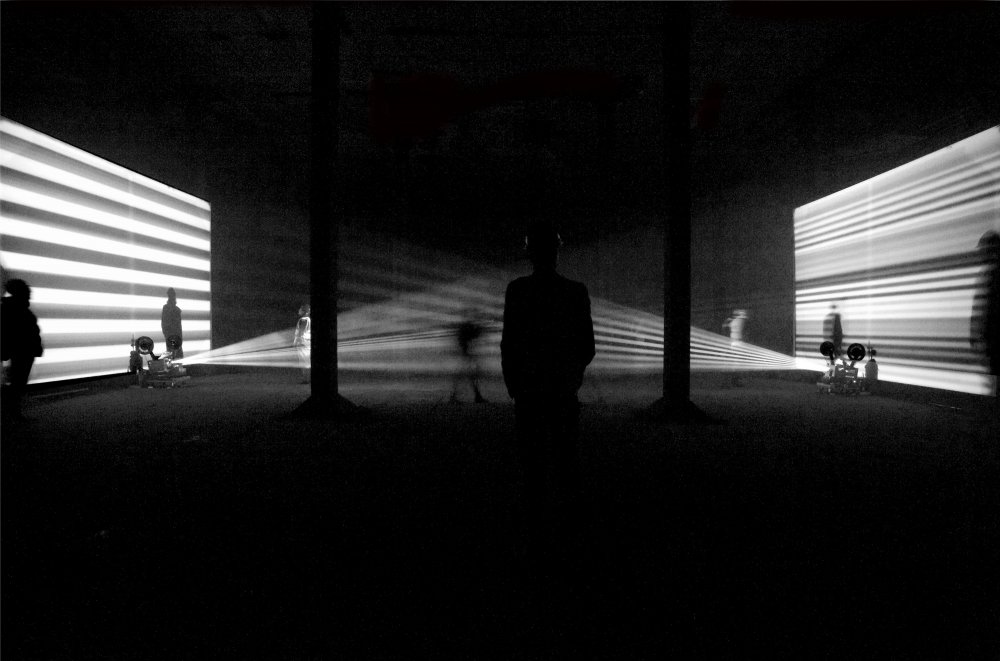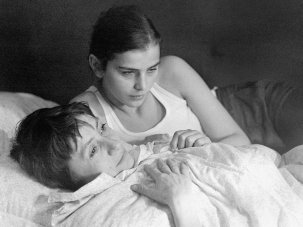“Film is history, many histories. Narrative leaps from the book, the headline, the news flash,” the British experimental filmmaker and feminist thinker Lis Rhodes wrote in Frieze magazine in 2012, around the time her career survey Dissidence and Disturbance was presented at the ICA Cinema in London. Another career survey now runs at Nottingham Contemporary. Dissident Lines presents Rhodes’s work from the 1970s to 2016, offering a rare opportunity to discover her gift for language and her uniqueness as an artist and thinker. And although Rhodes’s later works, devoted to the refugee crisis, worldwide anti-capitalist protests and global abuses of human rights, no doubt also form an illuminating body of work, I return to her early films as most unique and revelatory.
Lis Rhodes: Dissident Lines is at Nottingham Contemporary until 1 September 2019
In many ways, Rhodes’s entire career has been driven by the idea that too many histories pass unnoticed – fallen into oblivion, or never heard, seen, considered, in the first place. In the mid 1970s, while she was briefly a programmer at London’s Filmmakers Co-op, Rhodes first drew public attention to the lack of women in the arts. In her structuralist films, she showed how language itself was misogynist. This political agenda, though extremely important till today, is only half the story – to come into contact with Rhodes’s films, particularly the early ones, is to be transfixed by the vigorous playfulness of her approach, first to film as a material object, and then to language.
Rhodes made her first film, Dresden Dynamo (1971-72), while still studying at the North East London Polytechnic. At the Nottingham Contemporary, viewers are invited to lie down on beanbags to take in the ten-minute single-channel video.
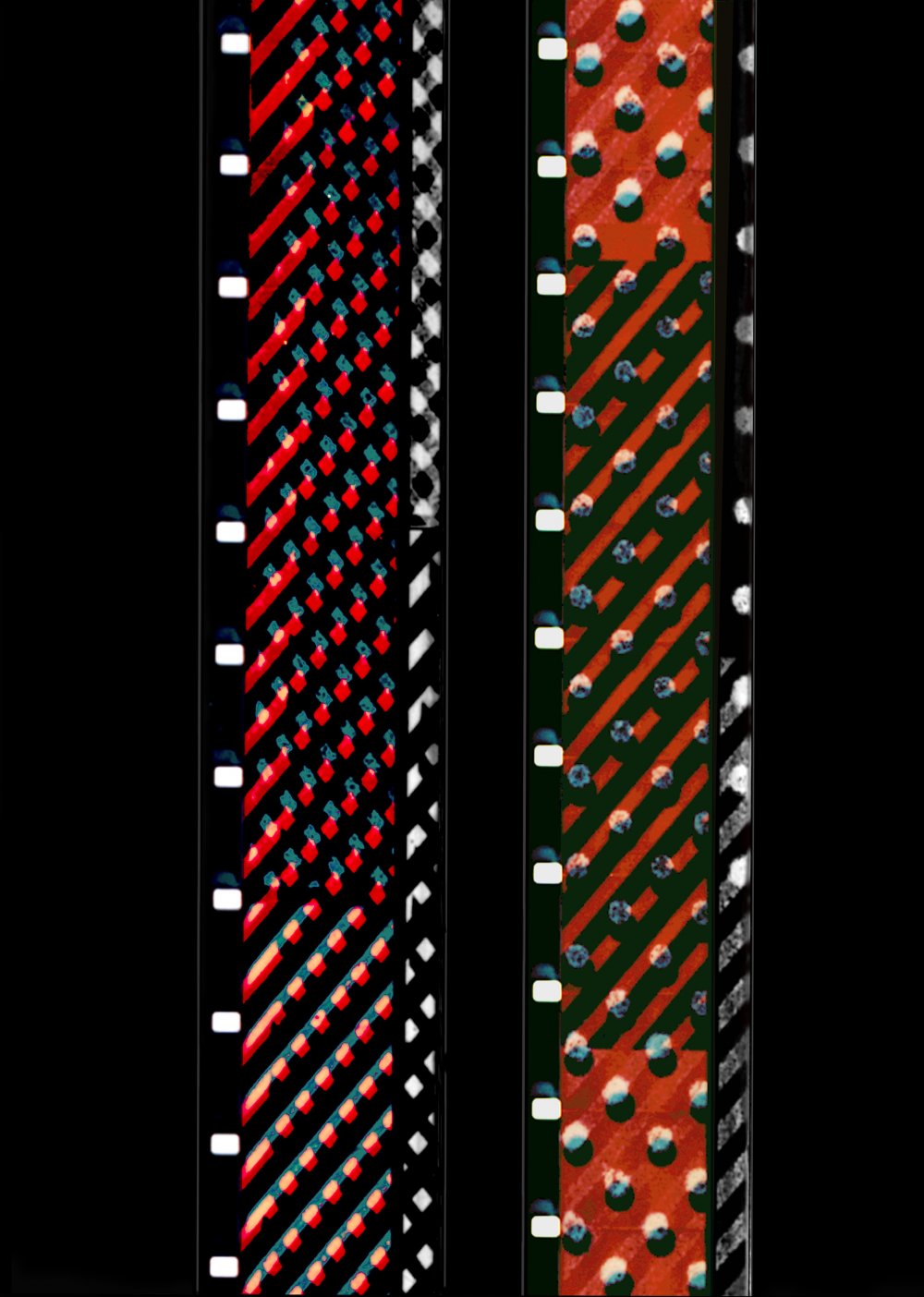
Dresden Dynamo (1971)
The comfortable setting in no way prepares us for the barrage of rapidly flickering geometric shapes – waves, dots, stripes, squares – mostly in primary red and blue. The sound is as if a syncopated horn sounded on a passing ship. Rhodes wanted to marry sound and image, and in this experiment, made without a camera, she affixed Letraset and Letratone stickers to the film, then used filters to make red and blue patterns. Since the stickers also covered the sound area of the film, when ran through the projector, the shapes generated the jarring sounds. As Rhodes says in the exhibition notes, “The image is the soundtrack – the soundtrack the image. A film document.”
Rhodes returned to the idea of creating a film document – one in which sound and image record and corroborate each other – in Light Music (1975-76), a 25-minute piece which at Nottingham Contemporary plays on two 16mm projectors facing each other. Visitors may pass through the stream of light and so interact with it.
Rhodes writes in the exhibit notes, “In the earliest film screenings, it was not possible to synchronise the two film projectors. And so I would move between the two – in a sense conducting them.”
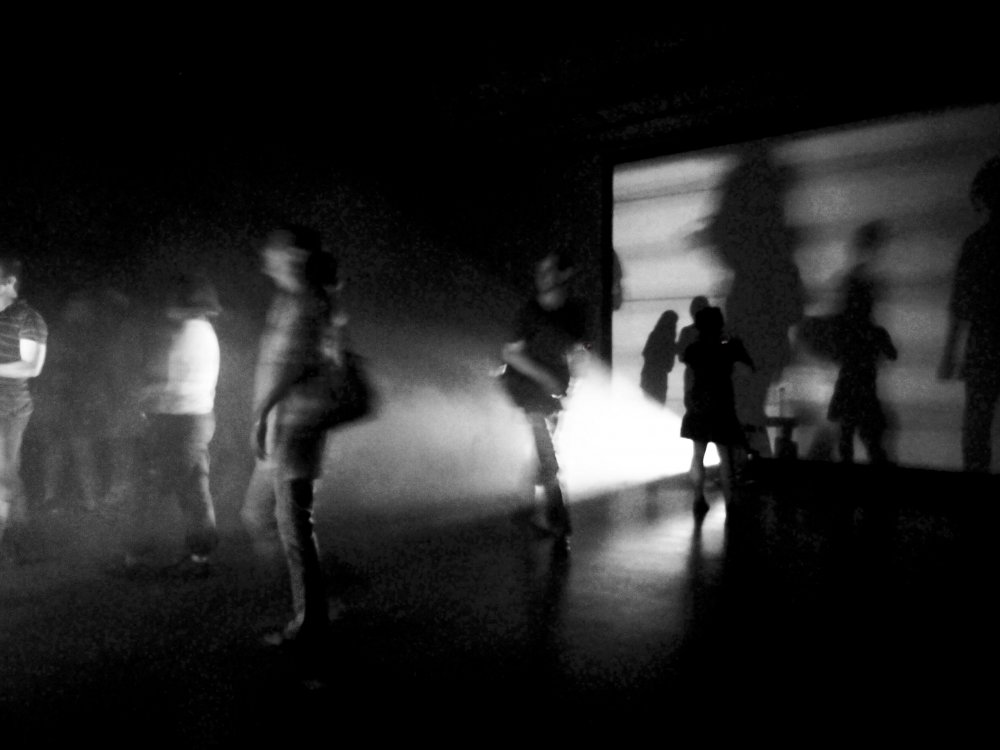
Light Music (1976)
Conducting with one’s body calls our attention to the artist’s physical presence and to subjectivity – something Rhodes would do more pointedly in subsequent films. In Light Music, the black-and-white beams on each screen stretch and shrink. The beams from the two projectors fill the space, and draw our attention to the sculptural quality of light. Rhodes filmed drawings with a rostrum camera, and then, as before, printed the images onto the optical soundtrack of the film. Once again, what we hear is the aural equivalent of the image.
Light Reading (1978) signalled a transition from Rhodes’s focus on pure sound to language as meaning, and as a cultural construct. Amy Taubin, who wrote on the film for the Village Voice noted that Rhodes “often uses mysterious, dangerous, and highly personal images”. Indeed, some of the images couldn’t be more personal – tussled bed sheets, often in extreme closeup. Rhodes zooms into the intimate setting, her camera behaving like the one in Michelangelo Antonioni’s Blow Up (1966).
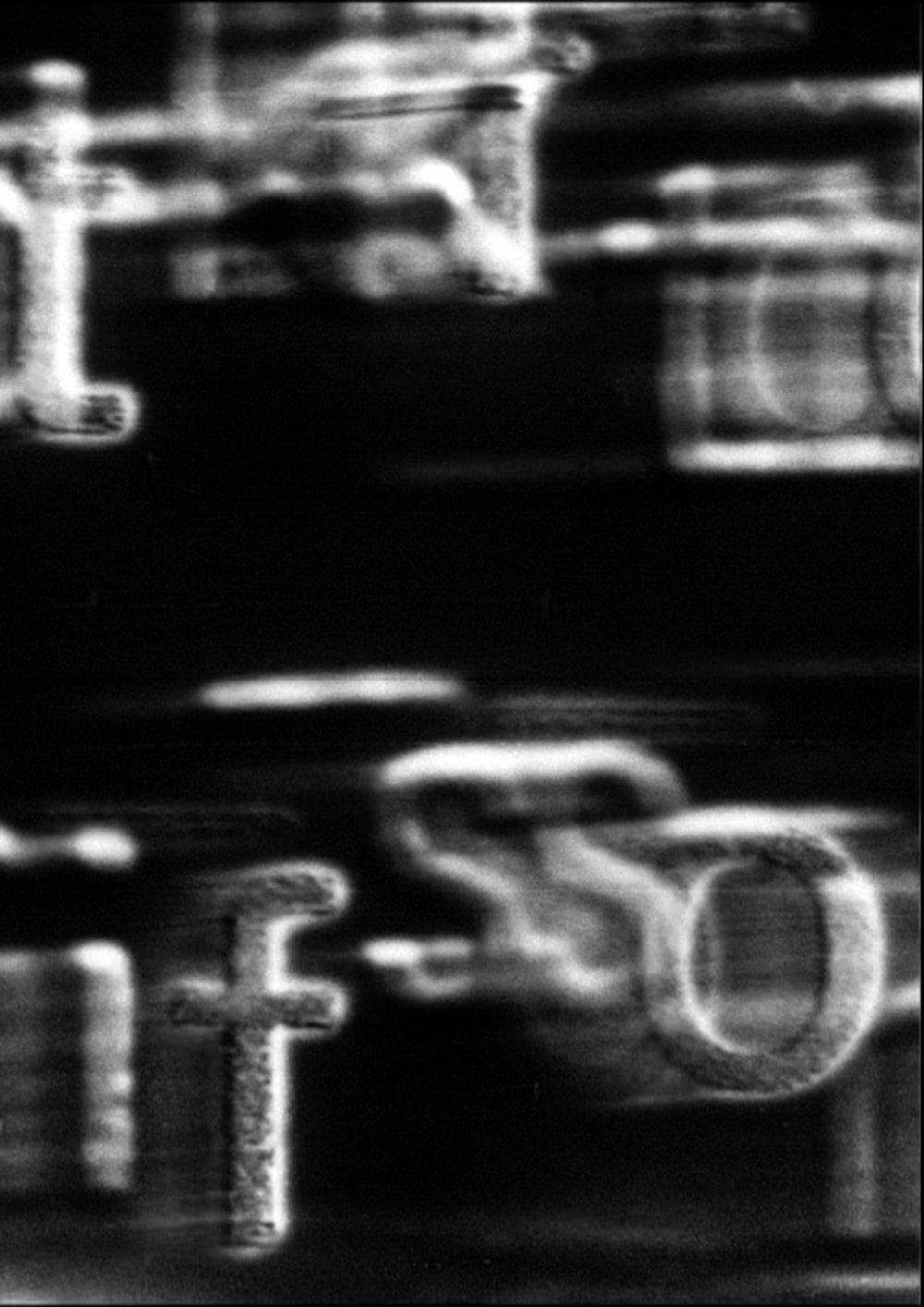
Light Reading (1979)
The setting feels like a crime scene – because Rhodes uses the camera and its zoom as analytical tools, to isolate and dissect – but the crime that interests her is once again linked to the questions of power, as relating to gender difference. Among the images are letters, often blurred and blown up, a measuring tape and a face covered by the camera’s lens. The latter signals that we’re thinking not just of the images themselves, but also of the act of taking a picture – the tension between subject/object, between the person who gets to be behind the camera and the other who appears before it.
This intricate relationship is best expressed by the female voice in the voiceover, which comes in after the first long silent section: “She watched herself being looked at / she looked at herself being watched / but she could not perceive herself / as the subject of the sentence.” The film-poem then slowly registers as a protest against the imposed framework. Meanwhile, the film’s pace leaves us breathless. The zoom is sharp, with no time for transitions. The rapid-fire editing brings up the same image many times, challenging our ability to see accurately. What is being seen? What does it mean to see? Is seeing a function of cropping, of framing?
These are familiar questions, often raised in discussions on the subjectivity of photographic image, but Rhodes turns this investigation into a game of hide-and-seek with the viewer, baiting us, as she impedes our reading. The title Light reading may suggest reading the light, determining how the image is to be taken, or instead reading lightly. Whatever Rhodes intends, she shows a clear preference for fleeting, light-footed work, keeping viewers always on our toes.
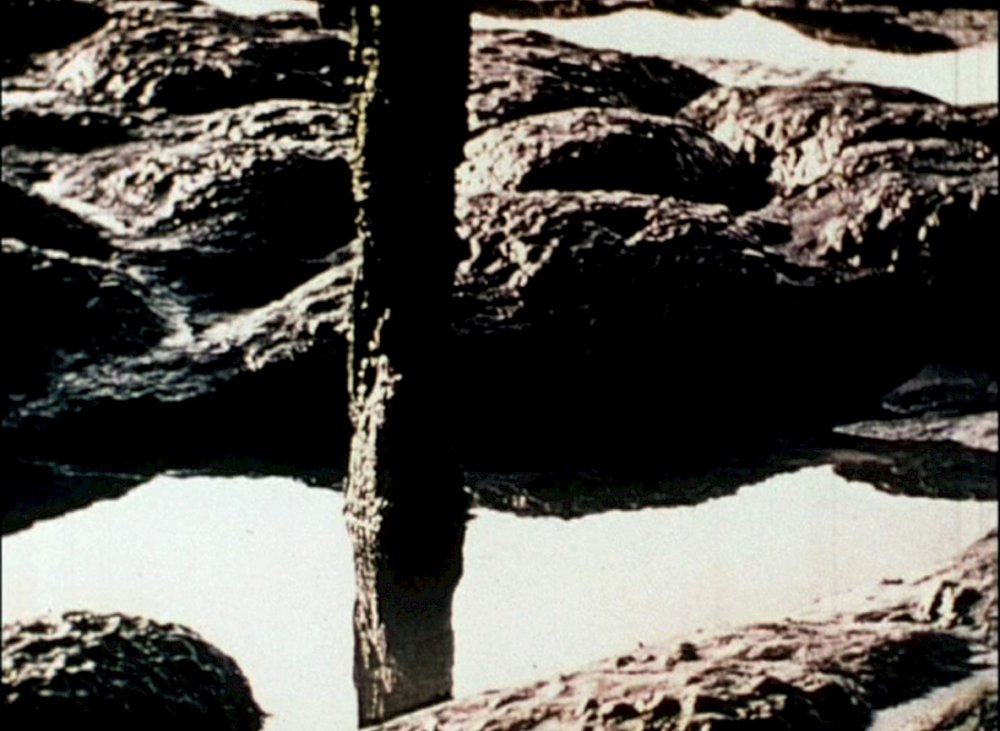
Pictures on Pink Paper (1982)
The 1980s were an important period in Rhodes’s work. Pictures on Pink Paper (1982) is a wondrous, Alice-in-Wonderland testament to her artistic prowess.
The film opens with a road surrounded by woods, with all the psychoanalytic associations that forests have in literature, as linked to the subconscious. Rhodes’s voiceover also delves into the murky, twisted workings of the subconscious. “Some days never existed,” a woman’s voice announces, while intertitles from time to time emphasise that we can never be sure where we are (“Out of Place,” reads one). Meanwhile the audio plays with and problematises the verb “to know”: “I thought I knew her,” “How do we know what nature is natural for us?”
As in a therapeutic trans, Rhodes takes us back to the images of a school, a home (“Was it the experience of violence that took her back to her childhood?”), while the voiceover warns, “Putting anything back where it belongs is always a shock.” The intermingling female voices are intimate but use only third-person pronouns. Images and sounds mix and repeat: the road, a sink, running water, clinking of dishes, voices. There are parallelisms between sound and image, but also multiple disjunctions and displacements. Rhodes also adds animation showing an older female figure, and in the audio, bits of nursery rhymes.
The result is polyphonic, as one voice becomes many, disorienting yet always driving at a singular source – a symbolic return to the origins of trauma. As one of the voices puts it, it is an attempt to catch meaning, which escapes us. “Meaning is not in things, it’s in between / between the sticky plates and coffee cups” – a corrective and an affirmation of domestic space as a locus of knowledge.
In Pictures on Pink Paper, Rhodes also avails herself of truisms (“reflections reflect”), quasi-nonsensical rhymes (“The witch bell rings / deal the cards she sings” or “She passed a cup of tea / who are you allowed to be / just a woman – quite like me”) and absurdist phrases, which paradoxically offer flashes of cutting wisdom. The sensation of oppression, of direct threat, slowly amplifies, as we hear women say things like, “I accepted their invasion,” or “I’m convinced that women know they are stronger / they carry men all the time.” And so we move away from catchy nursery rhymes to a more documentary approach, in which women appear to be giving testimonies in their kitchens. Meanwhile a title card reads “Natural Hystories” against an image of a fence. What are these ‘natural histories’? Histories that link women to nature, and to ‘natural’ rhythms of childbirth and housework, a cycle of unremunerated, unacknowledged labour?
All these questions arise from Rhodes’s stirring, mournful, disquieting work. The film has a rhythmic thrust of a song, and a lull of a nursery rhyme, yet at its heart is a dirge, an inconsolable cry. As such, it remains an absolutely essential viewing – remarkable not just for its collagist porousness, weaving disparate elements, stringing together titbits of popular and ethnographic tradition, but also as a poetic, visually bewildering document, and a very moving experience.
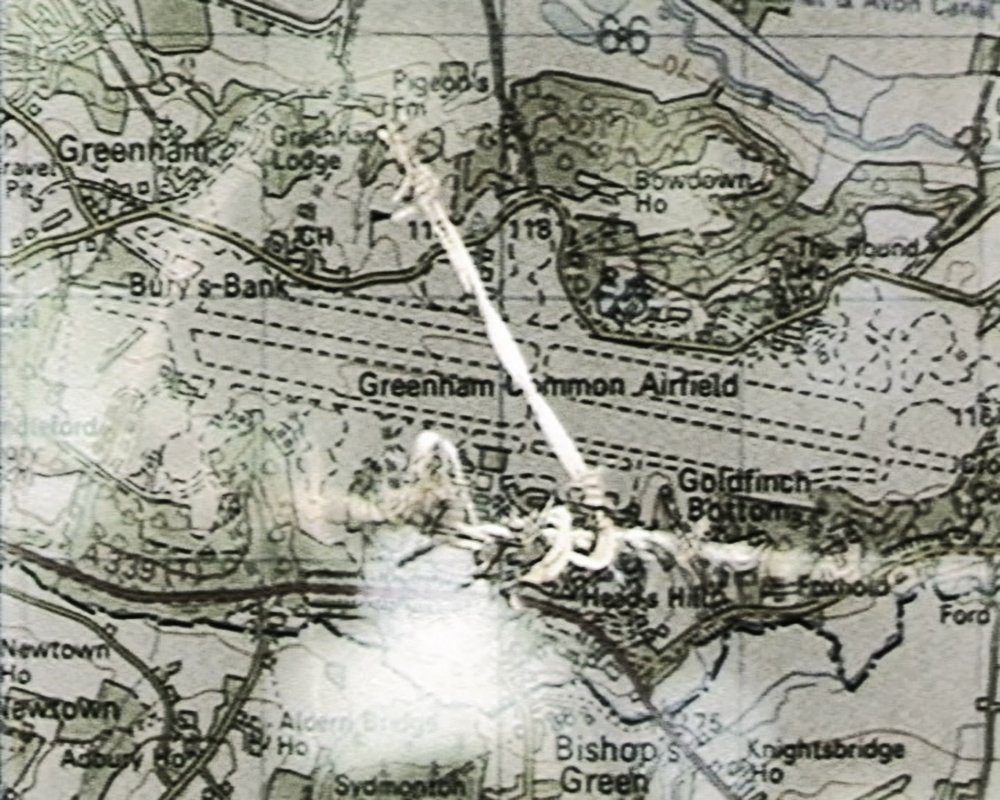
Hang on a Minute (1983-85)
Rhodes took an aphoristic approach to language in Pictures on Pink Paper, deploying rhymes and flash expressions to catch us unaware, and her next project, Hang on a Minute (1983-85), while different in placement, continued in a similar vein. Hang on a Minute, a 13-part series of one-minute 16mm films, which Rhodes co-directed with filmmaker Joanna Davis (who also founded Four Corners, a centre in London for film and photography), was commissioned by Channel 4. At Nottingham Contemporary, visitors view these on television sets, while seated in armchairs. In the end, only six episodes were shown; the rest apparently languished in the station’s legal department, due to their overtly political content.
Although the series signalled Rhodes expanding her subject matter – she and Davis tackled global issues, such as protests against nuclear weapons and England’s illegal mining in Africa – the first episode, Much Madness, played on the idea of women’s anger and protest, in the context of often fraught hospitalisation for mental illness. All shorts screened unannounced, in the midst of other programming, as if quick adverts. In this sense, Rhodes never gave up the idea of a therapeutic shock – putting things in their places, as she did with Pictures on Pink Paper, or radically reframing the conversation, like the narrator in Light Reading.
In her seminal essay Whose History? (1979), now reprinted along with other texts and film-poems in Telling Invents Told (the Visible Press, 2019, edited by María Palacios Cruz), Rhodes quotes the poet Gertrude Stein: “Define what you do by what you see never by what you know because you do not know that this is so.”
In a sense, Rhodes’s entire career stems from this paradox: to trust that the image can guide us by staying attentive to its deceptions. Indeed, Rhodes has used language and film both to evoke and to unmask their incantatory powers. There is morbidity yet also a sense of exhilaration in her penetrating, obsessive filmmaking, which suggests that we must always strive to listen more closely, look more carefully.
-
The Digital Edition and Archive quick link
Log in here to your digital edition and archive subscription, take a look at the packages on offer and buy a subscription.




